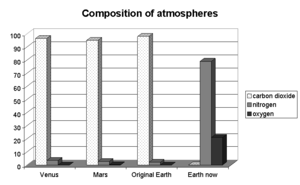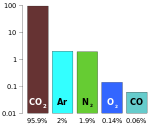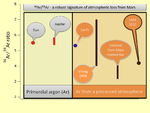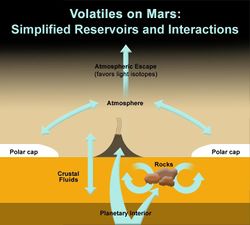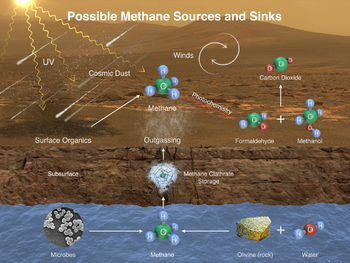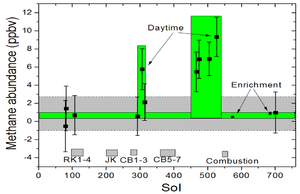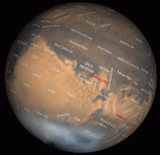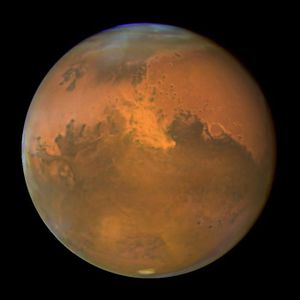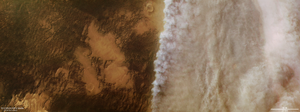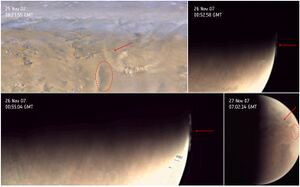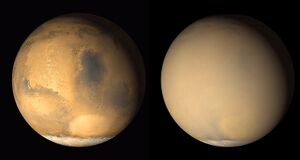الغلاف الجوي للمريخ
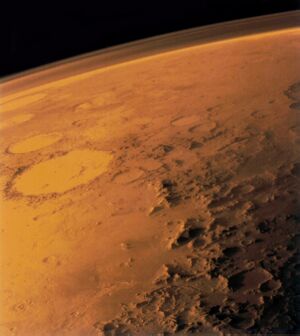 صورة المريخ وغلاف الجوي الرقيق، التقطتها ڤايكنگ 1 | |
| معلومات عامة[2] | |
|---|---|
| متوسط الضغط السطحي | 610 Pa (0.088 psi; 4.6 mmHg; 0.0060 atm) |
| الكتلة | 2.5x1016 kg[1] |
| التكوين[3][4] | |
| ثاني أكسيد الكربون | 95% |
| نيتروجين | 2.8% |
| أرگون | 2% |
| أكسجين | 0.174% |
| أول أكسيد الكربون | 0.0747% |
| بخار الماء | 0.03% (متغير) |
الغلاف الجوي للمشترى، هو مشابه الغلاف الجوي للزهرة، يتكون معظمه من ثاني أكسيد الكربون على الرغم من أنه أرق بكثير. تجدد الاهتمام بمكوناته منذ التحقق من وجود كميات ضئيلة جداً من الميثان عام 2003[5][6] والتي تشير لوجود حياة ربما قد نتجت أيضاً بواسطة عملية جيوميكانيكية، نشاط مائي حراري أو بركاني.[7]
يصل متوسط ضغط الجو على سطح المريخ إلى 600 پاسكال، حوالي 0.6% من متوسط ضغط مستوى سطح البحر على الأرض تصل إلى 103.3 پاسكال و0.0065% من 9.2 مليون پاسكال على الزهرة.
الغلاف الجوي للمريخ يتكون من حوالي 96% من ثاني أكسيد الكربون، 1.9% من الأراگون، 1.9% من النتروجين، وآثار من الأكسجين الحر، أول أكسيد الكربون، الماء والميثان وغازات أخرى،[8] لمتوسط كتلة مولية قيمتها 43.34 گ/مول.[9][10]
الغلاف الجوي مغبر تماماً، مما يعطي لسماء المريخ لوناً بنياً فاتحاً أو برتقالي-أحمر عند النظر للسطح؛ البيانات الواردة من جوال استكشاف المريخ تشير إلى أن جزئيات الغبار العالقة في الغلاف الجوي يصل قطرها إلى 1.5 ميكرومتر.[11]
في 14 ديسمبر 2014، أفادت ناسا عن التحقق من زيادة غير طبيعية، ثم انخفاض، في كميات الميثان بالغلاف الجوي لكوكب المريخ؛ كذلك؛ التحقق من وجود كيماويات عضوية مريخية في مسحوق تم الحصول عليه من حفر صخرة بواسطة الجوال كيريوسيتي. كذلك، تبعاً لدراسات حول نسبة الديوتريوم إلى الهيدروجين، معظم المياه في فوهة گال على المريخ التي عثر عليها فُقدت في الأوقات القديمة، قبل تشكل قاع البحيرة في الفوهة؛ بعدها، كميات ضخمة من المياه استمرت في الفقدان.[12][13][14]
وتُوجد ثلاثة أنواع من السحب في الغلاف الجوي المريخي. الأول قرنفلي اللون من الأتربة، وتغطي مساحات واسعة من الكوكب. والثانية سحب زرقاء اللون رقيقة وتظهر كأنها مصنوعة من بلورات ثلجية. أما النوع الثالث فهو سُحُب بيضاء أكبر سمكًا ويُعتقد أنها تتكون من بخار الماء، وتتحرك أحيانًا عبر سماء الكوكب.[15]
في نوفمبر 2015، أفاد بحث نشرت نتائجه مجلة ساينس بأن عاصفة شمسية تسببت في تدمير الغلاف الجوي، والمجال المغناطيسي لكوكب المريخ، وهو خيط مهم قد يميط اللثام عن لغز قديم يتعلق بكيفية تحول كوكب كان يشبه الأرض، إلى كوكب بارد وقاحل.
. . . . . . . . . . . . . . . . . . . . . . . . . . . . . . . . . . . . . . . . . . . . . . . . . . . . . . . . . . . . . . . . . . . . . . . . . . . . . . . . . . . . . . . . . . . . . . . . . . . . . . . . . . . . . . . . . . . . . . . . . . . . . . . . . . . . . . . . . . . . . . . . . . . . . . . . . . . . . . . . . . . . . . . .
تطور الغلاف الجوي
The mass and composition of the Martian atmosphere are thought to have changed over the course of the planet's lifetime. A thicker, warmer and wetter atmosphere is required to explain several apparent features in the earlier history of Mars, such as the existence of liquid water bodies. Observations of the Martian upper atmosphere, measurements of isotopic composition and analyses of Martian meteorites, provide evidence of the long-term changes of the atmosphere and constraints for the relative importance of different processes.
الغلاف الجوي في التاريخ المبكر
| نسبة النظائر | المريخ | الأرض | المريخ / الأرض |
|---|---|---|---|
| D / H (in H2O) | 9.3 ± 1.7 ‰[16][4] | 1.56 ‰[17] | ~6 |
| 12C / 13C | 85.1 ± 0.3[16][4] | 89.9[18] | 0.95 |
| 14N / 15N | 173 ± 9[16][19][4] | 272[17] | 0.64 |
| 16O / 18O | 476 ± 4.0[16][4] | 499[18] | 0.95 |
| 36Ar / 38Ar | 4.2 ± 0.1[20] | 5.305 ± 0.008[21] | 0.79 |
| 40Ar / 36Ar | 1900 ± 300[22] | 298.56 ± 0.31[21] | ~6 |
| C / 84Kr | (4.4–6) × 106[23][4] | 4 × 107[23][4] | ~0.1 |
| 129Xe / 132Xe | 2.5221 ± 0.0063[24] | 0.97[25] | ~2.5 |
In general, the gases found on modern Mars are depleted in lighter stable isotopes, indicating the Martian atmosphere has changed by some mass-selected processes over its history. Scientists often rely on these measurements of isotope composition to reconstruct conditions of the Martian atmosphere in the past.[26][27][28]
While Mars and Earth have similar 12C / 13C and 16O / 18O ratios, 14N is much more depleted in the Martian atmosphere. It is thought that the photochemical escape processes are responsible for the isotopic fractionation and has caused a significant loss of nitrogen on geological timescales.[4] Estimates suggest that the initial partial pressure of N2 may have been up to 30 hPa.[29][30]
Hydrodynamic escape in the early history of Mars may explain the isotopic fractionation of argon and xenon. On modern Mars, the atmosphere is not leaking these two noble gases to outer space owing to their heavier mass. However, the higher abundance of hydrogen in the Martian atmosphere and the high fluxes of extreme UV from the young Sun, together could have driven a hydrodynamic outflow and dragged away these heavy gases.[31][32][4] Hydrodynamic escape also contributed to the loss of carbon, and models suggest that it is possible to lose 1,000 hPa (1 bar) of CO2 by hydrodynamic escape in one to ten million years under much stronger solar extreme UV on Mars.[33] Meanwhile, more recent observations made by the MAVEN orbiter suggested that sputtering escape is very important for the escape of heavy gases on the nightside of Mars and could have contributed to 65% loss of argon in the history of Mars.[34][35][27]
The Martian atmosphere is particularly prone to impact erosion owing to the low escape velocity of Mars. An early computer model suggested that Mars could have lost 99% of its initial atmosphere by the end of late heavy bombardment period based on a hypothetical bombardment flux estimated from lunar crater density.[36] In terms of relative abundance of carbon, the C / 84 Kr ratio on Mars is only 10% of that on Earth and Venus. Assuming the three rocky planets have the same initial volatile inventory, then this low C / 84 Kr ratio implies the mass of CO2 in the early Martian atmosphere should have been ten times higher than the present value.[37] The huge enrichment of radiogenic 40Ar over primordial 36Ar is also consistent with the impact erosion theory.[4]
One of the ways to estimate the amount of water lost by hydrogen escape in the upper atmosphere is to examine the enrichment of deuterium over hydrogen. Isotope-based studies estimate that 12 m to over 30 m global equivalent layer of water has been lost to space via hydrogen escape in Mars' history.[38] It is noted that atmospheric-escape-based approach only provides the lower limit for the estimated early water inventory.[4]
To explain the coexistence of liquid water and faint young Sun during early Mars' history, a much stronger greenhouse effect must have occurred in the Martian atmosphere to warm the surface up above freezing point of water. Carl Sagan first proposed that a 1 bar H2 atmosphere can produce enough warming for Mars.[39] The hydrogen can be produced by the vigorous outgassing from a highly reduced early Martian mantle and the presence of CO2 and water vapor can lower the required abundance of H2 to generate such a greenhouse effect.[40] Nevertheless, photochemical modeling showed that maintaining an atmosphere with this high level of H2 is difficult.[41] SO2 has also been one of the proposed effective greenhouse gases in the early history of Mars.[42][43][44] However, other studies suggested that high solubility of SO2, efficient formation of H2SO4 aerosol and surface deposition prohibit the long-term build-up of SO2 in the Martian atmosphere, and hence reduce the potential warming effect of SO2.[4]
Atmospheric escape on modern Mars
Despite the lower gravity, Jeans escape is not efficient in the modern Martian atmosphere due to the relatively low temperature at the exobase (≈200 K at 200 km altitude). It can only explain the escape of hydrogen from Mars. Other non-thermal processes are needed to explain the observed escape of oxygen, carbon and nitrogen.
Hydrogen escape
Molecular hydrogen (H2) is produced from the dissociation of H2O or other hydrogen-containing compounds in the lower atmosphere and diffuses to the exosphere. The exospheric H2 then decomposes into hydrogen atoms, and the atoms that have sufficient thermal energy can escape from the gravitation of Mars (Jeans escape). The escape of atomic hydrogen is evident from the UV spectrometers on different orbiters.[45][46] While most studies suggested that the escape of hydrogen is close to diffusion-limited on Mars,[47][48] more recent studies suggest that the escape rate is modulated by dust storms and has a large seasonality.[49][50][51] The estimated escape flux of hydrogen range from 107 cm−2 s−1 to 109 cm−2 s−1.[50]
Carbon escape
Photochemistry of CO2 and CO in ionosphere can produce CO2+ and CO+ ions, respectively:
- CO
2 + hν ⟶ CO+
2 + e− - CO + hν ⟶ CO+
+ e−
An ion and an electron can recombine and produce electronic-neutral products. The products gain extra kinetic energy due to the Coulomb attraction between ions and electrons. This process is called dissociative recombination. Dissociative recombination can produce carbon atoms that travel faster than the escape velocity of Mars, and those moving upward can then escape the Martian atmosphere:
- CO+
+ e−
⟶ C + O - CO+
2 + e−
⟶ C + O
2
UV photolysis of carbon monoxide is another crucial mechanism for the carbon escape on Mars:[52]
- CO + hν (λ < 116 nm) ⟶ C + O.
Other potentially important mechanisms include the sputtering escape of CO2 and collision of carbon with fast oxygen atoms.[4] The estimated overall escape flux is about 0.6 × 107 cm−2 s−1 to 2.2 × 107 cm−2 s−1 and depends heavily on solar activity.[53][4]
Nitrogen escape
Like carbon, dissociative recombination of N2+ is important for the nitrogen escape on Mars.[54][55] In addition, other photochemical escape mechanism also play an important role:[54][56]
- N
2 + hν ⟶ N+
+ N + e− - N
2 + e−
⟶ N+
+ N + 2e−
Nitrogen escape rate is very sensitive to the mass of the atom and solar activity. The overall estimated escape rate of 14N is 4.8 × 105 cm−2 s−1.[54]
. . . . . . . . . . . . . . . . . . . . . . . . . . . . . . . . . . . . . . . . . . . . . . . . . . . . . . . . . . . . . . . . . . . . . . . . . . . . . . . . . . . . . . . . . . . . . . . . . . . . . . . . . . . . . . . . . . . . . . . . . . . . . . . . . . . . . . . . . . . . . . . . . . . . . . . . . . . . . . . . . . . . . . . .
Oxygen escape
Dissociative recombination of CO2+ and O2+ (produced from CO2+ reaction as well) can generate the oxygen atoms that travel fast enough to escape:
- CO+
2 + e−
⟶ CO + O - CO+
2 + O ⟶ O+
2 + CO - O+
2 + e−
⟶ O + O
However, the observations showed that there are not enough fast oxygen atoms the Martian exosphere as predicted by the dissociative recombination mechanism.[57][35] Model estimations of oxygen escape rate suggested it can be over 10 times lower than the hydrogen escape rate.[53][58] Ion pick and sputtering have been suggested as the alternative mechanisms for the oxygen escape, but this model suggests that they are less important than dissociative recombination at present.[59]
التركيب الكيميائي الحالي
| المكان | الضغط |
|---|---|
| قمة أقمار اوليمپس | 0.03 kilopascals (0.0044 psi) |
| متوسط المريخ | 0.6 kilopascals (0.087 psi) |
| قاع Hellas Planitia | 1.16 kilopascals (0.168 psi) |
| حد أرمسترونگ | 6.25 kilopascals (0.906 psi) |
| قمة جبل إڤرست[61] | 33.7 kilopascals (4.89 psi) |
| مستوى سطح البحر على الأرض | 101.3 kilopascals (14.69 psi) |
الرصد والقياس من الأرض
التكوين
ثاني أكسيد الكربون
الأرگون
الماء
الميثان
. . . . . . . . . . . . . . . . . . . . . . . . . . . . . . . . . . . . . . . . . . . . . . . . . . . . . . . . . . . . . . . . . . . . . . . . . . . . . . . . . . . . . . . . . . . . . . . . . . . . . . . . . . . . . . . . . . . . . . . . . . . . . . . . . . . . . . . . . . . . . . . . . . . . . . . . . . . . . . . . . . . . . . . .
ثاني أكسيد الكبريت
الأوزون
غبار الغلاف الجوي والسمات الديناميكية الأخرى
غبار الغلاف الجوي
Under sufficiently strong wind (> 30 ms−1), dust particles can be mobilized and lifted from the surface to the atmosphere.[2][4] Some of the dust particles can be suspended in the atmosphere and travel by circulation before falling back to the ground.[64] Dust particles can attenuate solar radiation and interact with infrared radiation, which can lead to a significant radiative effect on Mars. Orbiter measurements suggest that the globally-averaged dust optical depth has a background level of 0.15 and peaks in the perihelion season (southern spring and summer).[65] The local abundance of dust varies greatly by seasons and years.[65][66] During global dust events, Mars surface assets can observe optical depth that is over 4.[67][68] Surface measurements also showed the effective radius of dust particles ranges from 0.6 μm to 2 μm and has considerable seasonality.[68][69][70]
Dust has an uneven vertical distribution on Mars. Apart from the planetary boundary layer, sounding data showed that there are other peaks of dust mixing ratio at the higher altitude (e.g. 15–30 km above the surface).[71][72][64]
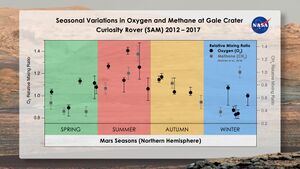
العواصف الترابية
Local and regional dust storms are not rare on Mars.[64][2] Local storms have a size of about 103 km2 and occurrence of about 2000 events per Martian year, while regional storms of 106 km2 large are observed frequently in southern spring and summer.[2] Near the polar cap, dust storms sometimes can be generated by frontal activities and extratropical cyclones.[73][64]
Global dust storms (area > 106 km2 ) occur on average once every 3 Martian years.[4] Observations showed that larger dust storms are usually the result of merging smaller dust storms,[74][75] but the growth mechanism of the storm and the role of atmospheric feedbacks are still not well understood.[75][64] Although it is thought that Martian dust can be entrained into the atmosphere by processes similar to Earth's (e.g. saltation), the actual mechanisms are yet to be verified, and electrostatic or magnetic forces may also play in modulating dust emission.[64] Researchers reported that the largest single source of dust on Mars comes from the Medusae Fossae Formation.[76]
On 1 June 2018, NASA scientists detected signs of a dust storm (see image) on Mars which resulted in the end of the solar-powered Opportunity rover's mission since the dust blocked the sunlight (see image) needed to operate. By 12 June, the storm was the most extensive recorded at the surface of the planet, and spanned an area about the size of North America and Russia combined (about a quarter of the planet). By 13 June, Opportunity rover began experiencing serious communication problems due to the dust storm.[77][78][79][80][81]
(Mars Climate Sounder; Mars Reconnaissance Orbiter)
(1:38; animation; 30 October 2018; file description)
الزوابع الترابية
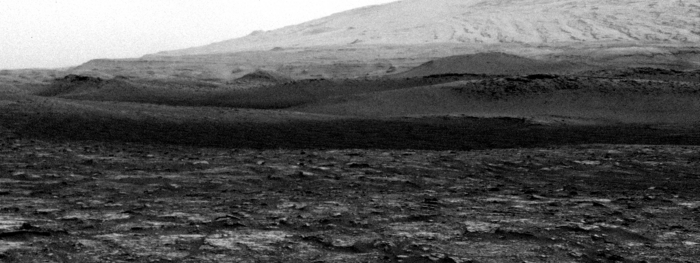
Dust devils are common on Mars.[82][64] Like their counterparts on Earth, dust devils form when the convective vortices driven by strong surface heating are loaded with dust particles.[83][84] Dust devils on Mars usually have a diameter of tens of meter and height of several kilometers, which are much taller than the ones observed on Earth.[2][84] Study of dust devils' tracks showed that most of Martian dust devils occur at around 60°N and 60°S in spring and summer.[82] They lift about 2.3 × 1011 kg of dust from land surface to atmosphere annually, which is comparable to the contribution from local and regional dust storms.[82]
تعديل الريح للسطح
On Mars, the near-surface wind is not only emitting dust but also modifying the geomorphology of Mars over long time scales. Although it was thought that the atmosphere of Mars is too thin for mobilizing the sandy features, observations made by HiRSE showed that the migration of dunes is not rare on Mars.[85][86][87] The global average migration rate of dunes (2 – 120 m tall) is about 0.5 meter per year.[87] Atmospheric circulation models suggested repeated cycles of wind erosion and dust deposition can lead, possibly, to a net transport of soil materials from the lowlands to the uplands on geological timescales.[4]
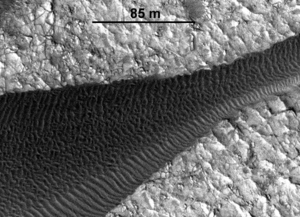
المد الحراري
Solar heating on the day side and radiative cooling on the night side of a planet can induce pressure difference.[88] Thermal tides, which are the wind circulation and waves driven by such a daily-varying pressure field, can explain a lot of variability of the Martian atmosphere.[89] Compared to Earth's atmosphere, thermal tides have a larger influence on the Martian atmosphere because of the stronger diurnal temperature contrast.[90] The surface pressure measured by Mars rovers showed clear signals of thermal tides, although the variation also depends on the shape of the planet's surface and the amount of suspended dust in the atmosphere.[91] The atmospheric waves can also travel vertically and affect the temperature and water-ice content in the middle atmosphere of Mars.[89]
Orographic clouds
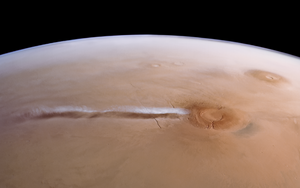
On Earth, mountain ranges sometimes force an air mass to rise and cool down. As a result, water vapor becomes saturated and clouds are formed during the lifting process.[92] On Mars, orbiters have observed a seasonally recurrent formation of huge water-ice clouds around the downwind side of the 20 km-high volcanoes Arsia Mons, which is likely caused by the same mechanism.[93][94]
إمكانية استيطان البشر
التاريخ
معرض الصور
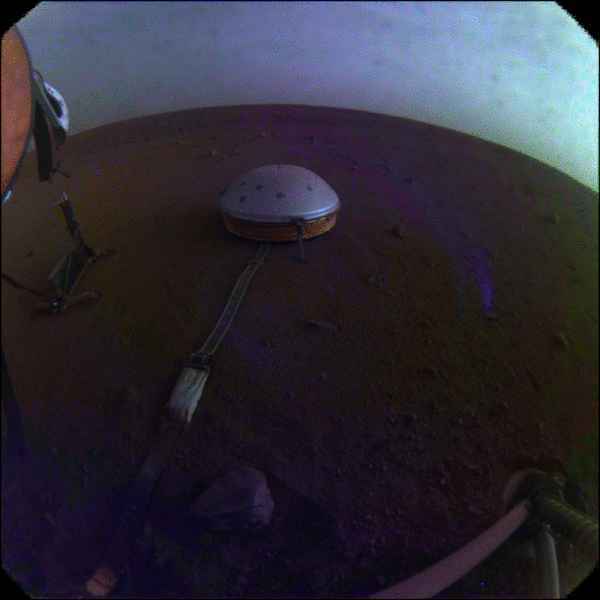
انظر ايضاً
المصادر
- ^ "Mars Fact Sheet". NASA. Archived from the original on 23 August 2021. Retrieved 2 December 2020.
- ^ أ ب ت ث ج خطأ استشهاد: وسم
<ref>غير صحيح؛ لا نص تم توفيره للمراجع المسماة:12 - ^ خطأ استشهاد: وسم
<ref>غير صحيح؛ لا نص تم توفيره للمراجع المسماة:63 - ^ أ ب ت ث ج ح خ د ذ ر ز س ش ص ض ط ظ خطأ استشهاد: وسم
<ref>غير صحيح؛ لا نص تم توفيره للمراجع المسماة:54 - ^ Interplanetary Whodunit – Methane on Mars, David Tenenbaum, Astrobiology Magazine, NASA, July 20, 2005. (Note: part one of a four-part series.)
- ^ Mumma, M. J.; Novak, R. E.; DiSanti, M. A.; Bonev, B. P., "A Sensitive Search for Methane on Mars" (abstract only). American Astronomical Society, DPS meeting #35, #14.18.
- ^ Making Sense of Mars Methane (June 2008)
- ^ خطأ استشهاد: وسم
<ref>غير صحيح؛ لا نص تم توفيره للمراجع المسماةAbundance - ^ Robbins, Stuart J.; et al. (14 September 2006). "Elemental composition of Mars' atmosphere". Case Western Reserve University Department of Astronomy. Archived from the original on 15 June 2011. Retrieved 5 April 2012.
{{cite web}}: Explicit use of et al. in:|author2=(help); Unknown parameter|deadurl=ignored (|url-status=suggested) (help) - ^ Seiff, A. and Kirk, D. (1977). "Structure of the atmosphere of Mars in summer at mid-latitudes" (abstract only). Journal of Geophysical Research, 82(28):4364–4378.
- ^ Lemmon et al., "Atmospheric Imaging Results from the Mars Exploration Rovers: Spirit and Opportunity"
- ^ Webster, Guy; Jones, Nancy Neal; Brown, Dwayne (16 December 2014). "NASA Rover Finds Active and Ancient Organic Chemistry on Mars". NASA. Retrieved 16 December 2014.
- ^ Chang, Kenneth (16 December 2014). "'A Great Moment': Rover Finds Clue That Mars May Harbor Life". New York Times. Retrieved 16 December 2014.
- ^ "Mars Atmosphere – The imprint of atmospheric evolution in the D/H of Hesperian clay minerals on Mars". Science (journal). 16 December 2014. doi:10.1126/science.1260291. Retrieved 16 December 2014.
{{cite journal}}: Cite uses deprecated parameter|authors=(help) - ^ "العلماء يكشفون لغز اختفاء الغلاف الجوي للمريخ". جريدة الحياة اللبنانية. 2015-11-06. Retrieved 2015-11-06.
- ^ أ ب ت ث Mahaffy, P.R.; Conrad, P.G.; MSL Science Team (2015-02-01). "Volatile and Isotopic Imprints of Ancient Mars". Elements. 11 (1): 51–56. doi:10.2113/gselements.11.1.51. ISSN 1811-5209.
- ^ أ ب Marty, Bernard (2012-01-01). "The origins and concentrations of water, carbon, nitrogen and noble gases on Earth". Earth and Planetary Science Letters. 313–314: 56–66. arXiv:1405.6336. Bibcode:2012E&PSL.313...56M. doi:10.1016/j.epsl.2011.10.040. ISSN 0012-821X. S2CID 41366698.
- ^ أ ب Henderson, Paul (2009). The Cambridge Handbook of Earth Science Data. Henderson, Gideon. Cambridge, UK: Cambridge University Press. ISBN 9780511580925. OCLC 435778559.
- ^ Wong, Michael H.; Atreya, Sushil K.; Mahaffy, Paul N.; Franz, Heather B.; Malespin, Charles; Trainer, Melissa G.; Stern, Jennifer C.; Conrad, Pamela G.; Manning, Heidi L.K. (2013-12-16). "Isotopes of nitrogen on Mars: Atmospheric measurements by Curiosity's mass spectrometer". Geophysical Research Letters. Mars atmospheric nitrogen isotopes. 40 (23): 6033–6037. Bibcode:2013GeoRL..40.6033W. doi:10.1002/2013GL057840. PMC 4459194. PMID 26074632.
- ^ Atreya, Sushil K.; Trainer, Melissa G.; Franz, Heather B.; Wong, Michael H.; Manning, Heidi L.K.; Malespin, Charles A.; Mahaffy, Paul R.; Conrad, Pamela G.; Brunner, Anna E. (2013). "Primordial argon isotope fractionation in the atmosphere of Mars measured by the SAM instrument on Curiosity and implications for atmospheric loss". Geophysical Research Letters. 40 (21): 5605–5609. Bibcode:2013GeoRL..40.5605A. doi:10.1002/2013GL057763. ISSN 1944-8007. PMC 4373143. PMID 25821261.
- ^ أ ب Lee, Jee-Yon; Marti, Kurt; Severinghaus, Jeffrey P.; Kawamura, Kenji; Yoo, Hee-Soo; Lee, Jin Bok; Kim, Jin Seog (2006-09-01). "A redetermination of the isotopic abundances of atmospheric Ar". Geochimica et Cosmochimica Acta. 70 (17): 4507–4512. Bibcode:2006GeCoA..70.4507L. doi:10.1016/j.gca.2006.06.1563. ISSN 0016-7037.
- ^ خطأ استشهاد: وسم
<ref>غير صحيح؛ لا نص تم توفيره للمراجع المسماة:25 - ^ أ ب Pepin, Robert O. (1991-07-01). "On the origin and early evolution of terrestrial planet atmospheres and meteoritic volatiles". Icarus. 92 (1): 2–79. Bibcode:1991Icar...92....2P. doi:10.1016/0019-1035(91)90036-S. ISSN 0019-1035.
- ^ خطأ استشهاد: وسم
<ref>غير صحيح؛ لا نص تم توفيره للمراجع المسماة:132 - ^ en:Xenon, oldid 900838642[مرجع دائرة مفرغة]
- ^ "Curiosity Sniffs Out History of Martian Atmosphere". NASA/JPL. Archived from the original on 28 July 2020. Retrieved 2019-06-11.
- ^ أ ب mars.nasa.gov. "NASA's MAVEN reveals most of Mars' atmosphere was lost to space". NASA's Mars Exploration Program. Archived from the original on 17 August 2020. Retrieved 2019-06-11.
- ^ Catling, David C.; Zahnle, Kevin J. (May 2009). "The planetary air leak" (PDF). Scientific American. p. 26. Archived (PDF) from the original on 26 October 2020. Retrieved 10 June 2019.
- ^ خطأ استشهاد: وسم
<ref>غير صحيح؛ لا نص تم توفيره للمراجع المسماةAv ice 20182 - ^ McElroy, Michael B.; Yung, Yuk Ling; Nier, Alfred O. (1 Oct 1976). "Isotopic Composition of Nitrogen: Implications for the Past History of Mars' Atmosphere". Science. 194 (4260): 70–72. Bibcode:1976Sci...194...70M. doi:10.1126/science.194.4260.70. PMID 17793081. S2CID 34066697.
- ^ Hunten, Donald M.; Pepin, Robert O.; Walker, James C.G. (1987-03-01). "Mass fractionation in hydrodynamic escape". Icarus. 69 (3): 532–549. Bibcode:1987Icar...69..532H. doi:10.1016/0019-1035(87)90022-4. hdl:2027.42/26796. ISSN 0019-1035.
- ^ Hans Keppler; Shcheka, Svyatoslav S. (October 2012). "The origin of the terrestrial noble-gas signature". Nature. 490 (7421): 531–534. Bibcode:2012Natur.490..531S. doi:10.1038/nature11506. ISSN 1476-4687. PMID 23051754. S2CID 205230813.
- ^ Tian, Feng; Kasting, James F.; Solomon, Stanley C. (2009). "Thermal escape of carbon from the early Martian atmosphere". Geophysical Research Letters. 36 (2): n/a. Bibcode:2009GeoRL..36.2205T. doi:10.1029/2008GL036513. ISSN 1944-8007. S2CID 129208608.
- ^ Jakosky, B.M.; Slipski, M.; Benna, M.; Mahaffy, P.; Elrod, M.; Yelle, R.; Stone, S.; Alsaeed, N. (2017-03-31). "Mars' atmospheric history derived from upper-atmosphere measurements of 38 Ar / 36 Ar". Science. 355 (6332): 1408–1410. Bibcode:2017Sci...355.1408J. doi:10.1126/science.aai7721. ISSN 0036-8075. PMID 28360326.
- ^ أ ب Leblanc, F.; Martinez, A.; Chaufray, J. Y.; Modolo, R.; Hara, T.; Luhmann, J.; Lillis, R.; Curry, S.; McFadden, J. (2018). "On Mars's Atmospheric Sputtering After MAVEN's First Martian Year of Measurements" (PDF). Geophysical Research Letters. 45 (10): 4685–4691. Bibcode:2018GeoRL..45.4685L. doi:10.1002/2018GL077199. ISSN 1944-8007. S2CID 134561764.
- ^ Vickery, A.M.; Melosh, H.J. (April 1989). "Impact erosion of the primordial atmosphere of Mars". Nature. 338 (6215): 487–489. Bibcode:1989Natur.338..487M. doi:10.1038/338487a0. ISSN 1476-4687. PMID 11536608. S2CID 4285528.
- ^ Owen, Tobias; Bar-Nun, Akiva (1995-08-01). "Comets, impacts, and atmospheres". Icarus. 116 (2): 215–226. Bibcode:1995Icar..116..215O. doi:10.1006/icar.1995.1122. ISSN 0019-1035. PMID 11539473.
- ^ Krasnopolsky, Vladimir A. (2002). "Mars' upper atmosphere and ionosphere at low, medium, and high solar activities: Implications for evolution of water". Journal of Geophysical Research: Planets. 107 (E12): 11‑1–11‑11. Bibcode:2002JGRE..107.5128K. doi:10.1029/2001JE001809. ISSN 2156-2202.
- ^ Sagan, Carl (September 1977). "Reducing greenhouses and the temperature history of Earth and Mars". Nature. 269 (5625): 224–226. Bibcode:1977Natur.269..224S. doi:10.1038/269224a0. ISSN 1476-4687. S2CID 4216277.
- ^ Kasting, James F.; Freedman, Richard; Robinson, Tyler D.; Zugger, Michael E.; Kopparapu, Ravi; Ramirez, Ramses M. (January 2014). "Warming early Mars with CO2 and H2". Nature Geoscience. 7 (1): 59–63. arXiv:1405.6701. Bibcode:2014NatGe...7...59R. doi:10.1038/ngeo2000. ISSN 1752-0908. S2CID 118520121.
- ^ Batalha, Natasha; Domagal-Goldman, Shawn D.; Ramirez, Ramses; Kasting, James F. (2015-09-15). "Testing the early Mars H2–CO2 greenhouse hypothesis with a 1-D photochemical model". Icarus. 258: 337–349. arXiv:1507.02569. Bibcode:2015Icar..258..337B. doi:10.1016/j.icarus.2015.06.016. ISSN 0019-1035. S2CID 118359789.
- ^ Johnson, Sarah Stewart; Mischna, Michael A.; Grove, Timothy L.; Zuber, Maria T. (2008-08-08). "Sulfur-induced greenhouse warming on early Mars". Journal of Geophysical Research. 113 (E8): E08005. Bibcode:2008JGRE..113.8005J. doi:10.1029/2007JE002962. ISSN 0148-0227. S2CID 7525497.
- ^ Schrag, Daniel P.; Zuber, Maria T.; Halevy, Itay (2007-12-21). "A sulfur dioxide climate feedback on early Mars". Science. 318 (5858): 1903–1907. Bibcode:2007Sci...318.1903H. doi:10.1126/science.1147039. ISSN 0036-8075. PMID 18096802. S2CID 7246517.
- ^ "Sulfur dioxide may have helped maintain a warm early Mars". phys.org. Archived from the original on 8 June 2019. Retrieved 2019-06-08.
- ^ Anderson, Donald E. (1974). "Mariner 6, 7, and 9 Ultraviolet Spectrometer Experiment: Analysis of hydrogen Lyman alpha data". Journal of Geophysical Research. 79 (10): 1513–1518. Bibcode:1974JGR....79.1513A. doi:10.1029/JA079i010p01513. ISSN 2156-2202.
- ^ Chaufray, J.Y.; Bertaux, J.L.; Leblanc, F.; Quémerais, E. (June 2008). "Observation of the hydrogen corona with SPICAM on Mars Express". Icarus. 195 (2): 598–613. Bibcode:2008Icar..195..598C. doi:10.1016/j.icarus.2008.01.009.
- ^ Hunten, Donald M. (November 1973). "The Escape of Light Gases from Planetary Atmospheres". Journal of the Atmospheric Sciences. 30 (8): 1481–1494. Bibcode:1973JAtS...30.1481H. doi:10.1175/1520-0469(1973)030<1481:TEOLGF>2.0.CO;2. ISSN 0022-4928.
- ^ Zahnle, Kevin; Haberle, Robert M.; Catling, David C.; Kasting, James F. (2008). "Photochemical instability of the ancient Martian atmosphere". Journal of Geophysical Research: Planets. 113 (E11): E11004. Bibcode:2008JGRE..11311004Z. doi:10.1029/2008JE003160. ISSN 2156-2202. S2CID 2199349.
- ^ Bhattacharyya, D.; Clarke, J. T.; Chaufray, J. Y.; Mayyasi, M.; Bertaux, J. L.; Chaffin, M. S.; Schneider, N. M.; Villanueva, G. L. (2017). "Seasonal Changes in Hydrogen Escape From Mars Through Analysis of HST Observations of the Martian Exosphere Near Perihelion" (PDF). Journal of Geophysical Research: Space Physics. 122 (11): 11, 756–11, 764. Bibcode:2017JGRA..12211756B. doi:10.1002/2017JA024572. ISSN 2169-9402. S2CID 119084288. Archived (PDF) from the original on 5 November 2020. Retrieved 6 January 2021.
- ^ أ ب Schofield, John T.; Shirley, James H.; Piqueux, Sylvain; McCleese, Daniel J.; Paul O. Hayne; Kass, David M.; Halekas, Jasper S.; Chaffin, Michael S.; Kleinböhl, Armin (February 2018). "Hydrogen escape from Mars enhanced by deep convection in dust storms". Nature Astronomy. 2 (2): 126–132. Bibcode:2018NatAs...2..126H. doi:10.1038/s41550-017-0353-4. ISSN 2397-3366. S2CID 134961099.
- ^ Shekhtman, Svetlana (2019-04-29). "How Global Dust Storms Affect Martian Water, Winds, and Climate". NASA. Archived from the original on 17 June 2019. Retrieved 2019-06-10.
- ^ Nagy, Andrew F.; Liemohn, Michael W.; Fox, J. L.; Kim, Jhoon (2001). "Hot carbon densities in the exosphere of Mars". Journal of Geophysical Research: Space Physics. 106 (A10): 21565–21568. Bibcode:2001JGR...10621565N. doi:10.1029/2001JA000007. ISSN 2156-2202. Archived from the original on 28 July 2020. Retrieved 24 November 2019.
- ^ أ ب Gröller, H.; Lichtenegger, H.; Lammer, H.; Shematovich, V. I. (2014-08-01). "Hot oxygen and carbon escape from the martian atmosphere". Planetary and Space Science. Planetary evolution and life. 98: 93–105. arXiv:1911.01107. Bibcode:2014P&SS...98...93G. doi:10.1016/j.pss.2014.01.007. ISSN 0032-0633. S2CID 122599784.
- ^ أ ب ت Fox, J. L. (1993). "The production and escape of nitrogen atoms on Mars". Journal of Geophysical Research: Planets. 98 (E2): 3297–3310. Bibcode:1993JGR....98.3297F. doi:10.1029/92JE02289. ISSN 2156-2202. Archived from the original on 21 July 2018. Retrieved 24 June 2019.
- ^ Mandt, Kathleen; Mousis, Olivier; Chassefière, Eric (July 2015). "Comparative planetology of the history of nitrogen isotopes in the atmospheres of Titan and Mars". Icarus. 254: 259–261. Bibcode:2015Icar..254..259M. doi:10.1016/j.icarus.2015.03.025. PMC 6527424. PMID 31118538.
- ^ Fox, J.L. (December 2007). "Comment on the papers "Production of hot nitrogen atoms in the martian thermosphere" by F. Bakalian and "Monte Carlo computations of the escape of atomic nitrogen from Mars" by F. Bakalian and R.E. Hartle". Icarus. 192 (1): 296–301. Bibcode:2007Icar..192..296F. doi:10.1016/j.icarus.2007.05.022.
- ^ Feldman, Paul D.; Steffl, Andrew J.; Parker, Joel Wm.; A'Hearn, Michael F.; Bertaux, Jean-Loup; Alan Stern, S.; Weaver, Harold A.; Slater, David C.; Versteeg, Maarten (2011-08-01). "Rosetta-Alice observations of exospheric hydrogen and oxygen on Mars". Icarus. 214 (2): 394–399. arXiv:1106.3926. Bibcode:2011Icar..214..394F. doi:10.1016/j.icarus.2011.06.013. ISSN 0019-1035. S2CID 118646223.
- ^ Lammer, H.; Lichtenegger, H.I.M.; Kolb, C.; Ribas, I.; Guinan, E.F.; Abart, R.; Bauer, S.J. (September 2003). "Loss of water from Mars". Icarus. 165 (1): 9–25. doi:10.1016/S0019-1035(03)00170-2.
- ^ Valeille, Arnaud; Bougher, Stephen W.; Tenishev, Valeriy; Combi, Michael R.; Nagy, Andrew F. (2010-03-01). "Water loss and evolution of the upper atmosphere and exosphere over martian history". Icarus. Solar Wind Interactions with Mars. 206 (1): 28–39. Bibcode:2010Icar..206...28V. doi:10.1016/j.icarus.2009.04.036. ISSN 0019-1035.
- ^ أ ب Jones, Nancy; Steigerwald, Bill; Brown, Dwayne; Webster, Guy (14 October 2014). "NASA Mission Provides Its First Look at Martian Upper Atmosphere". NASA. Archived from the original on 19 October 2014. Retrieved 15 October 2014. خطأ استشهاد: وسم
<ref>غير صالح؛ الاسم "NASA-20141014-NJ" معرف أكثر من مرة بمحتويات مختلفة. - ^ John B. West – Barometric pressures on Mt. Everest: new data and physiological significance (1998)
- ^ Webster, Guy (8 April 2013). "Remaining Martian Atmosphere Still Dynamic". NASA. Retrieved 9 April 2013.
- ^ Wall, Mike (8 April 2013). "Most of Mars' Atmosphere Is Lost in Space". Space.com. Retrieved 9 April 2013.
- ^ أ ب ت ث ج ح خ خطأ استشهاد: وسم
<ref>غير صحيح؛ لا نص تم توفيره للمراجع المسماة:202 - ^ أ ب Smith, Michael D. (2004-01-01). "Interannual variability in TES atmospheric observations of Mars during 1999–2003". Icarus. Special Issue on DS1 / Comet Borrelly. 167 (1): 148–165. Bibcode:2004Icar..167..148S. doi:10.1016/j.icarus.2003.09.010. ISSN 0019-1035.
- ^ Montabone, L.; Forget, F.; Millour, E.; Wilson, R.J.; Lewis, S.R.; Cantor, B.; et al. (2015-05-01). "Eight-year climatology of dust optical depth on Mars". Icarus. Dynamic Mars. 251: 65–95. arXiv:1409.4841. Bibcode:2015Icar..251...65M. doi:10.1016/j.icarus.2014.12.034. ISSN 0019-1035. S2CID 118336315.
- ^ NASA/JPL-Caltech/TAMU. "Atmospheric opacity from Opportunity's point of view". NASA's Mars Exploration Program. Archived from the original on 9 June 2019. Retrieved 2019-06-09.
- ^ أ ب Lemmon, Mark T.; Wolff, Michael J.; Bell, James F.; Smith, Michael D.; Cantor, Bruce A.; Smith, Peter H. (2015-05-01). "Dust aerosol, clouds, and the atmospheric optical depth record over 5 Mars years of the Mars Exploration Rover mission". Icarus. Dynamic Mars. 251: 96–111. arXiv:1403.4234. Bibcode:2015Icar..251...96L. doi:10.1016/j.icarus.2014.03.029. ISSN 0019-1035. S2CID 5194550.
- ^ Chen-Chen, H.; Pérez-Hoyos, S.; Sánchez-Lavega, A. (2019-02-01). "Dust particle size and optical depth on Mars retrieved by the MSL navigation cameras". Icarus. 319: 43–57. arXiv:1905.01073. Bibcode:2019Icar..319...43C. doi:10.1016/j.icarus.2018.09.010. ISSN 0019-1035. S2CID 125311345.
- ^ Vicente-Retortillo, Álvaro; Martínez, Germán M.; Renno, Nilton O.; Lemmon, Mark T.; de la Torre-Juárez, Manuel (2017). "Determination of dust aerosol particle size at Gale Crater using REMS UVS and Mastcam measurements". Geophysical Research Letters. 44 (8): 3502–3508. Bibcode:2017GeoRL..44.3502V. doi:10.1002/2017GL072589. ISSN 1944-8007.
- ^ McCleese, D.J.; Heavens, N.G.; Schofield, J.T.; Abdou, W.A.; Bandfield, J.L.; Calcutt, S.B.; et al. (2010). "Structure and dynamics of the Martian lower and middle atmosphere as observed by the Mars Climate Sounder: Seasonal variations in zonal mean temperature, dust, and water ice aerosols" (PDF). Journal of Geophysical Research. Planets. 115 (E12): E12016. Bibcode:2010JGRE..11512016M. doi:10.1029/2010JE003677. ISSN 2156-2202. S2CID 215820851. Archived (PDF) from the original on 15 August 2017. Retrieved 24 June 2019.
- ^ Guzewich, Scott D.; Talaat, Elsayed R.; Toigo, Anthony D.; Waugh, Darryn W.; McConnochie, Timothy H. (2013). "High-altitude dust layers on Mars: Observations with the Thermal Emission Spectrometer". Journal of Geophysical Research. Planets. 118 (6): 1177–1194. Bibcode:2013JGRE..118.1177G. doi:10.1002/jgre.20076. ISSN 2169-9100.
- ^ Read, P L; Lewis, S R; Mulholland, D P (2015-11-04). "The physics of Martian weather and climate: a review" (PDF). Reports on Progress in Physics. 78 (12): 125901. Bibcode:2015RPPh...78l5901R. doi:10.1088/0034-4885/78/12/125901. ISSN 0034-4885. PMID 26534887. S2CID 20087052. Archived (PDF) from the original on 20 July 2018. Retrieved 24 June 2019.
- ^ خطأ استشهاد: وسم
<ref>غير صحيح؛ لا نص تم توفيره للمراجع المسماة:40 - ^ أ ب خطأ استشهاد: وسم
<ref>غير صحيح؛ لا نص تم توفيره للمراجع المسماةToigo 514–536 - ^ Ojha, Lujendra; Lewis, Kevin; Karunatillake, Suniti; Schmidt, Mariek (20 July 2018). "The Medusae Fossae Formation as the single largest source of dust on Mars". Nature Communications. 9 (2867 (2018)): 2867. Bibcode:2018NatCo...9.2867O. doi:10.1038/s41467-018-05291-5. PMC 6054634. PMID 30030425.
- ^ Malik, Tariq (13 June 2018). "As Massive Storm Rages on Mars, Opportunity Rover Falls Silent - Dust clouds blotting out the sun could be the end of the solar-powered probe". Scientific American. Archived from the original on 13 June 2018. Retrieved 13 June 2018.
- ^ Wall, Mike (12 June 2018). "NASA's Curiosity Rover Is Tracking a Huge Dust Storm on Mars (Photo)". Space.com. Archived from the original on 21 December 2020. Retrieved 13 June 2018.
- ^ Good, Andrew; Brown, Dwayne; Wendell, JoAnna (12 June 2018). "NASA to Hold Media Teleconference on Martian Dust Storm, Mars Opportunity Rover". NASA. Archived from the original on 21 June 2018. Retrieved 12 June 2018.
- ^ Good, Andrew (13 June 2018). "NASA Encounters the Perfect Storm for Science". NASA. Archived from the original on 25 June 2018. Retrieved 14 June 2018.
- ^ NASA Staff (13 June 2018). "Mars Dust Storm News - Teleconference - audio (065:22)". NASA. Archived from the original on 13 June 2018. Retrieved 13 June 2018.
- ^ أ ب ت Whelley, Patrick L.; Greeley, Ronald (2008). "The distribution of dust devil activity on Mars". Journal of Geophysical Research: Planets. 113 (E7): E07002. Bibcode:2008JGRE..113.7002W. doi:10.1029/2007JE002966. ISSN 2156-2202.
- ^ Balme, Matt; Greeley, Ronald (2006). "Dust devils on Earth and Mars". Reviews of Geophysics. 44 (3): RG3003. Bibcode:2006RvGeo..44.3003B. doi:10.1029/2005RG000188. ISSN 1944-9208. S2CID 53391259.
- ^ أ ب "The Devils of Mars | Science Mission Directorate". science.nasa.gov. Archived from the original on 26 December 2018. Retrieved 2019-06-11.
- ^ Stolte, Daniel; Communications, University (22 May 2019). "On Mars, Sands Shift to a Different Drum". UANews. Archived from the original on 4 June 2019. Retrieved 2019-06-11.
- ^ "NASA - NASA Orbiter Catches Mars Sand Dunes in Motion". www.nasa.gov. Archived from the original on 26 July 2020. Retrieved 2019-06-11.
- ^ أ ب Urso, Anna C.; Fenton, Lori K.; Banks, Maria E.; Chojnacki, Matthew (2019-05-01). "Boundary condition controls on the high-sand-flux regions of Mars". Geology. 47 (5): 427–430. Bibcode:2019Geo....47..427C. doi:10.1130/G45793.1. ISSN 0091-7613. PMC 7241575. PMID 32440031.
- ^ "Thermal tide - AMS Glossary". glossary.ametsoc.org. Archived from the original on 26 July 2020. Retrieved 2019-06-11.
- ^ أ ب Lee, C.; Lawson, W. G.; Richardson, M. I.; Heavens, N. G.; Kleinböhl, A.; Banfield, D.; McCleese, D. J.; Zurek, R.; Kass, D. (2009). "Thermal tides in the Martian middle atmosphere as seen by the Mars Climate Sounder". Journal of Geophysical Research: Planets. 114 (E3): E03005. Bibcode:2009JGRE..114.3005L. doi:10.1029/2008JE003285. ISSN 2156-2202. PMC 5018996. PMID 27630378.
- ^ خطأ استشهاد: وسم
<ref>غير صحيح؛ لا نص تم توفيره للمراجع المسماة:182 - ^ "NASA - Thermal Tides at Mars". www.nasa.gov. Archived from the original on 17 June 2019. Retrieved 2019-06-11.
- ^ "Orographic cloud - AMS Glossary". glossary.ametsoc.org. Archived from the original on 10 September 2019. Retrieved 2019-06-11.
- ^ esa. "Mars Express keeps an eye on curious cloud". European Space Agency. Archived from the original on 15 June 2019. Retrieved 2019-06-11.
- ^ rburnham. "Mars Express: Keeping an eye on a curious cloud | Red Planet Report". Archived from the original on 27 September 2019. Retrieved 2019-06-11.
قراءات إضافية
- "Mars Clouds Higher Than Any On Earth". Space.com.
- Mikulski, Lauren (2000). "Pressure on the Surface of Mars". The Physics Factbook.
- "Atmospheric pressure – summary of the Viking lander results".
- Khan, Michael (4 December 2009). "The Low Down on Methane on Mars". Archived from the original on 7 December 2009. Retrieved 8 December 2009.
{{cite web}}: Unknown parameter|deadurl=ignored (|url-status=suggested) (help) - "A seasonal ozone layer over the Martian south pole". publisher=ESA. 29 September 2013. Retrieved 17 December 2013.
{{cite web}}: Missing pipe in:|work=(help); Unknown parameter|deadurl=ignored (|url-status=suggested) (help)
وصلات خارجية
 Media related to الغلاف الجوي للمريخ at Wikimedia Commons
Media related to الغلاف الجوي للمريخ at Wikimedia Commons
- CS1 errors: unsupported parameter
- CS1 errors: deprecated parameters
- All articles lacking reliable references
- Articles lacking reliable references from November 2019
- Short description is different from Wikidata
- Articles with hatnote templates targeting a nonexistent page
- Pages using columns-list with unknown parameters
- CS1 errors: missing pipe
- الغلاف الجوي للمريخ
- أجواء الكواكب
- المريخ
- أجواء كواكب النظام الشمسي


